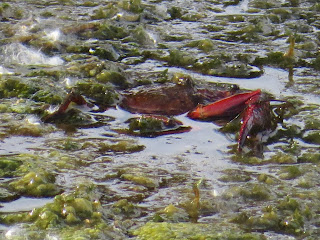The best part about nature watching is when you see the unusual or unexplained. Observing what is always there can get old, but things seen in a new light can bring a new perspective.
If you see a a common thing in a new way it always brings insight. These night herons visit during this time of year, and this candid view of a shy bird hiding in the trees above a feeding site was a lucky shot.
They use the irrigated fields to lunch up on small fish and tadpoles. There is never more than one around at a time, unlike the gregarious cattle egrets. That is likely because of the different sources of food. Egrets feed on insects and benefit for others flushing them out. Heron feed by ambushing fish and need stealth.
The fields that are flooded are the most productive for wildlife, but it takes community to keep the gates and ditches cleaned. Repairs are easy if it is just digging that is needed, the downside is that the repairs are pretty much constant.

The rains are bringing growth to the plants, this cultivated hibiscus is a pretty fancy specimen. The amount of work that does into growing plant species of gardeners is astonishing.
During the rains, many moths seem shelter under the stucco roofs. It is odd to see them out during the day. Many birds like flycatchers are chasing after them right now.
The winds and moisture brought down a large number of tree branches. Tree trimmers, both municipal and private have been busy today.
The extra water in the ditches have allowed the turtles to move around more freely. The sliders like the deeper water.
The large snappers seem to prefer the shallow waters, they are likely looking for carrion, like a dead raccoon. I swear this picture shows a red crab, which is an unusual animal, but the ditch is host to many released pets during the summer. It MIGHT be a crayfish, but I don't think so.
A yellow throated...something. The songbirds are singing up a storm at the moment. Right now is the middle of nesting season.
This is a towhee, usually they are on the ground, but I guess they like to advertise too.
The doves are also calling, but then again. they do this all year, it seems
Other secretive birds come in for brief periods. This is definitely a great blue heron feather. Herons like to fish from the banks, especially during periods where the river level is high.
This is a towhee, usually they are on the ground, but I guess they like to advertise too.
The doves are also calling, but then again. they do this all year, it seems
Other secretive birds come in for brief periods. This is definitely a great blue heron feather. Herons like to fish from the banks, especially during periods where the river level is high.
The plants are hard at work breaking down the building projects. Roots use hydrostatic pressure over time to enlarge cracks in concrete very effectively. The concrete is suseptible to contraction and expansion as the temperature changes so cheap concrete exposed to the atmosphere is not pristine for long.
This is the first time I have seen the grass growing in the clay on the bottom, usually the water flow is enough to flush the mud out into the clear ditch.
The warm sun has allowed algae and water weeds to begin colonizing new territory. The fine clay muds consolidate quickly when the water slows and resist being flushed. This surface allows plant colonization. Most fish prefer a sandy, clear water substrate.
The rains and sun allow many vareities of plants to thrive. Thee are many dense stands of nightshade right now, but a few surprises, like this...(tomatillo?) plant.
Light rains means migrations for animals. Here the new crop of toadlets are spreading out into the big world.
Darkling beetles are meeting and mating. They are often seen around the nests of harvester ants. I have never seen the beetles in tandem wonder if they are mating, or wrestling?
The velvet ants I see now have wings, so I assume they are male. The wings are stiff and leathery to resist ant bites I guess.
They seem to have very short life spans, The congregate in some areas, presumably near a female. They certainly act oddly for an ant species
Ants come in many shapes and sizes. This is the first time I have seen a golden color, though. The picture is hard to make out, but I think there are some emerging drones in the hole that are black colored. Ants often swarm like this during damp days.
There are large numbers of these golden meadowhawks around. They seem to prefer hanging out on plant stems, instead of being over a stream.The dragonflies in the plants are much smaller, but more than one species. This blue one looks like a damselfly in color.
A thread waisted wasp like this is usually some sort of caterpillar parasite. This one also seemed to be feeding on pollen.
There are actually many animals dead on the road right now. A tragic intersection of migration behaviors, dumb luck, and rubber. Many animals have switched to night living near humans to reduce these impacts. Toads, rabbits, and skunks make up the majority of these roadkills. Luckily the reproduce fast enough to compensate. The problem is highways like our I-25 and I-40 can also fragment and disrupt whole ecosystems. No animal that doesn't fly is going to be able to cross 6 lanes of freeway during any time of day. The drains that occasionally go under and might offer access are not exactly inviting for a wild animal, with the noise. Also, all access points are always watched over by predators such as coyote. Cars are such a huge problem for wildlife, and the whole planet.





























I like the format & all of the pictures in this one.
ReplyDelete